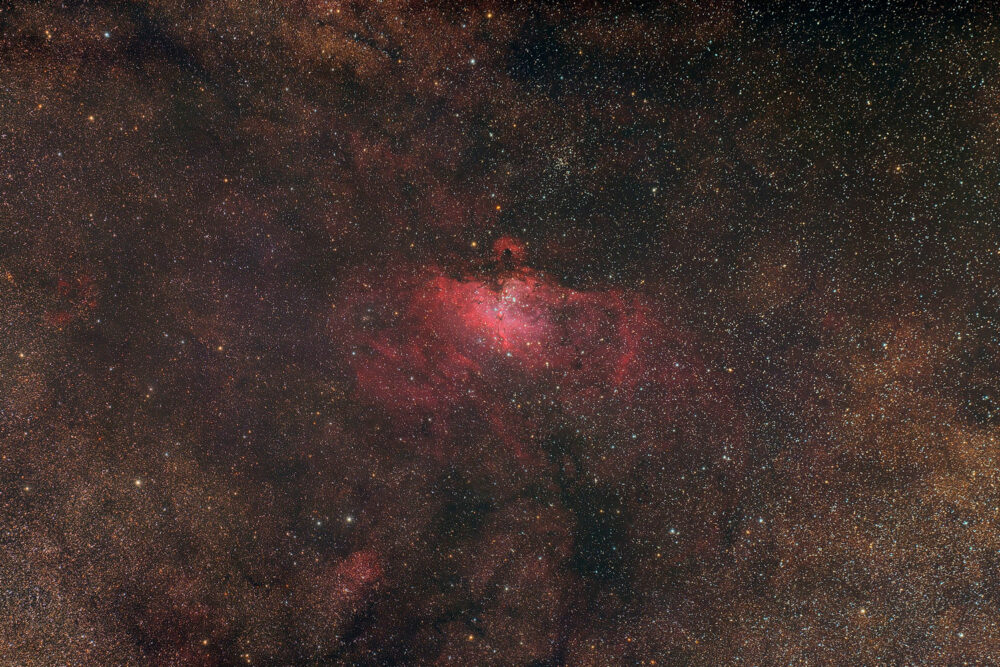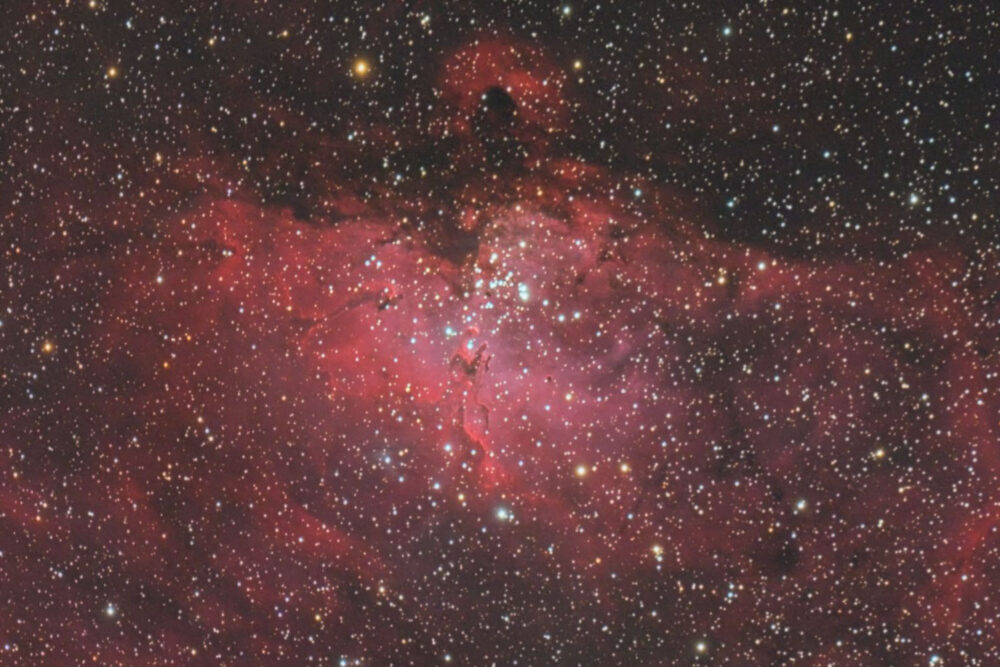Category : Ciel profond
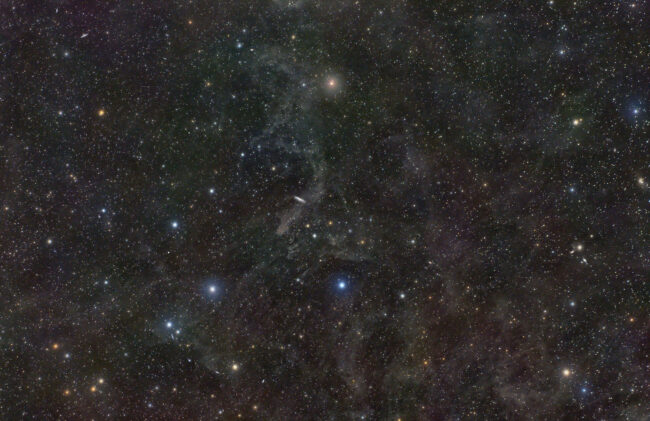
Astrophotography night on the Vercors High Plateau from September 18 to 19. We heard the deer roaring all night long!
NGC 7497 is a galaxy located 24 Mpc, or 79 million light years, in Pegasus. It is also well behind the interstellar dust of our galaxy.
39 x 5 min
Camera : Nikon Z6 partially unfiltered
Telescope : Takahashi FSQ-106ED refractor.
Mount : ZWO AM5N.
Guiding : ZWO ASI290MM Mini on QHY OAG-M
Temperature : 3°C
Humidity : 100%
SQM : 21.3
Software : acquisition with Astro Photography Tool, processing with PixInsight.
Location : Vercors Highlands
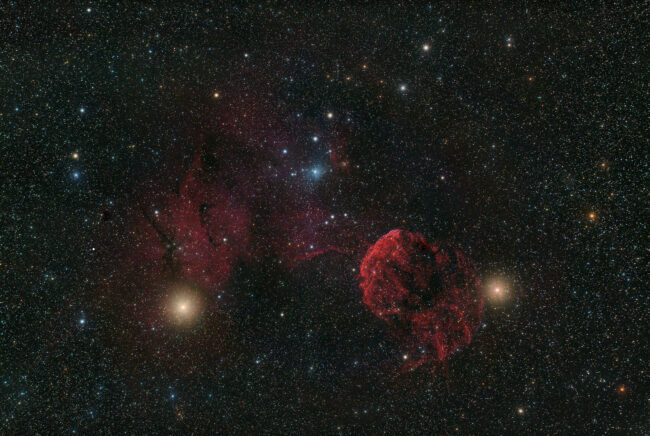
Clear and moonless sky for New Year’s Eve. I had to go out. The target was IC 443, a beautiful nebula in Gemini. A target I had already photographed in February 2023 but I didn’t remember it!
IC 443 is a supernova remnant that is believed to have exploded 30,000 – 35,000 years ago.
62 x 2 min
Camera : Nikon Z6 partially unfiltered
Telescope : Takahashi FSQ-106ED refractor.
Mount : ZWO AM5N.
Guiding : ZWO ASI290MM Mini on QHY OAG-M
Temperature : -3°C, -1°C
Humidity : 80%
SQM : 21.1
Software : acquisition with Astro Photography Tool, processing with PixInsight.
Location : Le Plan, Le Banchet
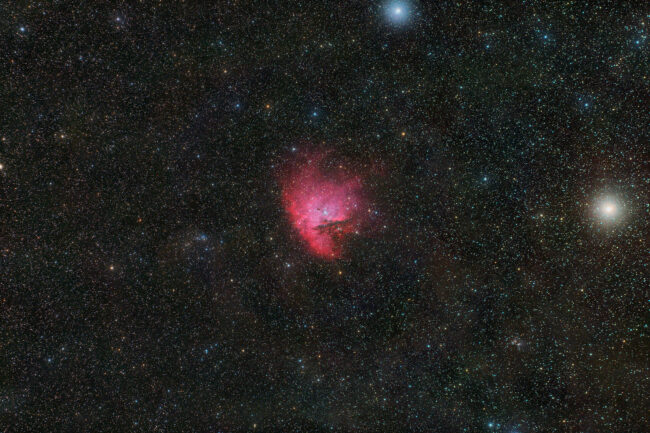
NGC 281 is a HII region, a cloud of ionized hydrogen, located in Cassiopeia. It is about 10,000 light-years from Earth with a diameter of 100 light-years. Its shape roughly resembles to Pac-Man, hence its name.
Acquired on December 28, 2024 for the production launch of my new ZWO AM5N equatorial mount which allows me to lighten the setup by 30 kg. A very appreciable weight saving in nomadic astrophotography!
54 x 2 min
Camera : Nikon Z6 partially unfiltered
Telescope : Takahashi FSQ-106ED refractor.
Mount : ZWO AM5N.
Guiding : ZWO ASI290MM Mini on QHY OAG-M
Temperature : 1°C
Humidity : 70%
SQM : 20.9
Software : acquisition with Astro Photography Tool, processing with PixInsight.
Location : Le Plan, Le Banchet
The Eagle Nebula is one of the classic summer observations near Sagittarius. It is located further north, in the constellation of the Serpens. M16 actually designates the open cluster in the center of the nebula which itself bears the designation IC 4703.
The central part became popular after the portrait made of it by the Hubble space telescope in 1995. It is a stars nursery, hence the somewhat high-sounding name as the Americans like Pillars of Creation
74 x 2 min
Camera : Nikon Z6 partially unfiltered
Telescope : Takahashi FSQ-106ED refractor.
Mount : Takahashi EM-200 homemade electronics.
Guiding : ZWO ASI290MM Mini on QHY OAG-M
Temperature : 13°C
Humidity : 70%
SQM : 21.6
Software : auto-guiding with PHD2, acquisition with Astro Photography Tool, processing with PixInsight.
Location : L’Epine
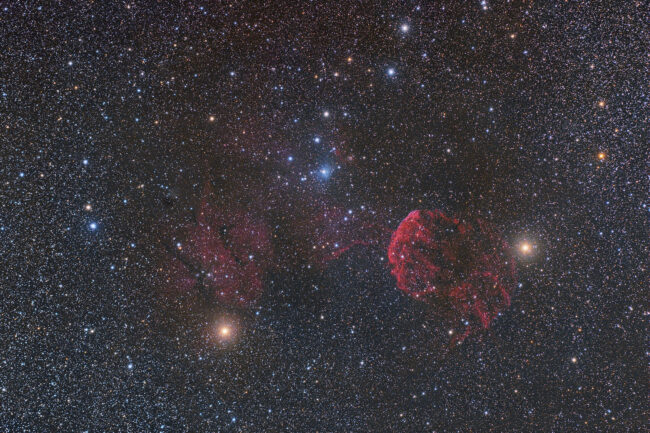
It’s a supernova remnant in the constellation Gemini. I did not know her before making the photo.
27 x 2 min
Camera : Nikon Z6 partially unfiltered
Telescope : Takahashi FSQ-106ED refractor.
Mount : Takahashi EM-200 homemade electronics.
Guiding : ZWO ASI290MM Mini on QHY OAG-M
Temperature : 3 to 1°C
Humidity : 85% to 100%
SQM : 21.2
Software : auto-guiding with PHD2, acquisition with Astro Photography Tool, processing with PixInsight.
Location : L’Epine
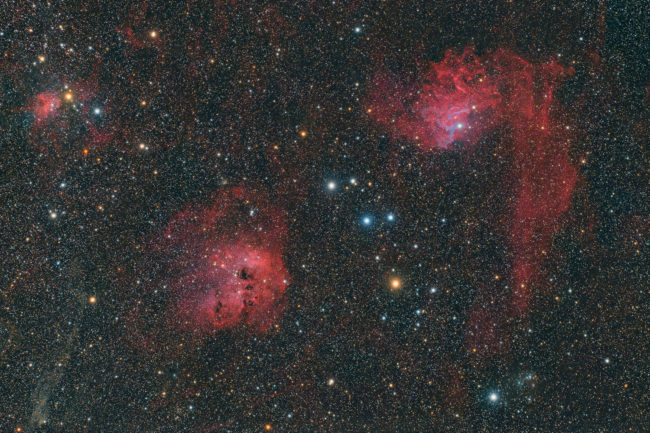
From left to right, or from smallest to largest:
– IC 417, the small Spider Nebula
– IC 410, the Tadpoles
– IC 405, the Flaming Star Nebula
Shot on December 31, 2021, about an hour before we change the year. And that’s the only deep sky image of the year, a crappy weather year.
65 x 1 min
Camera : Nikon Z6 partially unfiltered
Telescope : Takahashi FSQ-106ED refractor.
Mount : Takahashi EM-200 homemade electronics.
Temperature : 7°C
Humidity : 65%
SQM : 21.0
Software : acquisition with Astro Photography Tool, processing with PixInsight.
Location : Le Plan, Col du Banchet
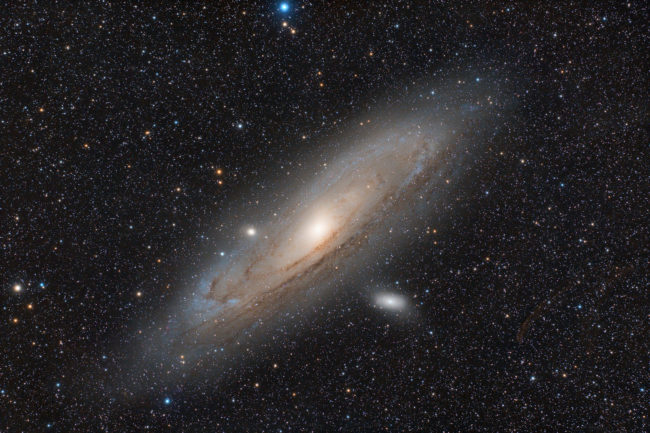
The girl next door,
The neighbor,
Great is beautiful.
Well especially in photos because, visually, it is rather a big blurry spot. I call it a big cosmic scam for newbies. The Andromeda Galaxy is the large galaxy located right next to ours just 2.5 million light years away. It is the most famous. It is the most distant object that you can see with the naked eye. So inevitably, the beginner in astronomy will quickly point his brand new telescope on it to see … a blurred spot! And then you’ll see him appear on the forums to ask if he’s pointed at the right place or if his telescope is out of order. No no, everything is normal, there’s just nothing more to see! In fact, it is better to observe him with a simple pair of binoculars.
For this photo the acquisitions were made on the night of Saturday October 17 to Sunday 18 under rather specific conditions. 0 ° C and 100% humidity. I was wondering if it’s that wet when it rains! Everything was soaked. I wiped the PC screen with kleenex. On the refractor I have a heating element to prevent due which did the job very well, to my astonishment. The Nikon Z6 refuses to recognize the fake battery that allows me to power it with a large 4S li-ion. Forcing to put the real battery on it, which necessarily limited the autonomy. At 4 a.m. it was covered with a good layer of frost. And finally, there is a flare. So I will have to redo it. Probably in 4 or 5 years, time to bring together the right conditions at the right time.
49 x 1 min
Camera : Nikon Z6 partially unfiltered
Telescope : Takahashi FSQ-106ED refractor.
Mount : Takahashi EM-200 homemade electronics.
Guiding : ZWO ASI290MM Mini on QHY OAG-M
Temperature : 0°C
Humidity : 100%
SQM : 21.55
Software : auto-guiding with PHD2, acquisition with Astro Photography Tool, processing with PixInsight.
Location : L’Epine
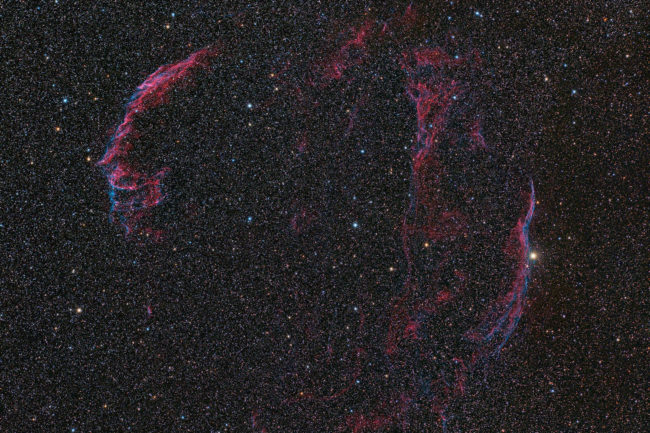
For this one, I choose to translate the french title. In english it is better known as Cygnus Loop or Veil Nebula. I thing the french name is more poetic.
The remains of a star that exploded about ten thousand years ago. We call it a supernova remnant.
It’s a great summer classic. I never miss to go to observe it visually. It is a pleasure to stroll along the filaments, from the large lace (on the left) to the small (on the right) via the Volutes of Williamina Fleming. Sometimes when the sky is really good, I can perceive other weaker part.
60 x 1 min
Camera : Nikon Z6 partially unfiltered
Telescope : Takahashi FSQ-106ED refractor.
Mount : Takahashi EM-200 homemade electronics.
Guiding : ZWO ASI290MM Mini on QHY OAG-M
Temperature : 23°C
SQM : 21
Software : auto-guiding with PHD2, acquisition with Astro Photography Tool, processing with PixInsight.
Location : Le Plan, Col du Banchet
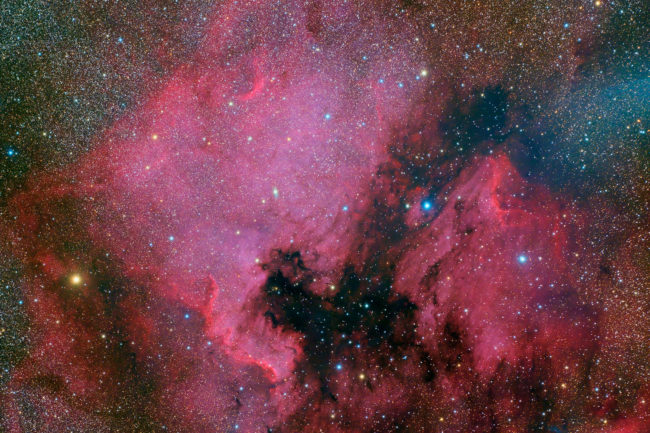
Yes, they even have their nebula… I’m not telling you where the North America Nebula is or why we call it like that, it’s pretty obvious. It’s identified as NGC 7000. To its right is the Pelican Nebula, IC 5067 and IC 5070. The bird is a little harder to recognize.
These nebulae represent only part of the H-alpha complex found in the Cygnus. Ionized hydrogen is found in a large part of the constellation and even beyond.
90 x 1 min
Camera : Nikon Z6 partially unfiltered
Telescope : Takahashi FSQ-106ED refractor.
Mount : Takahashi EM-200 homemade electronics.
Guiding : ZWO ASI290MM Mini on QHY OAG-M
Temperature : 7°C
Humidity : 84%
SQM : 21.4
Software : auto-guiding with PHD2, acquisition with Astro Photography Tool, processing with PixInsight.
Location : Le Serpaton, Gresse-en-Vercors
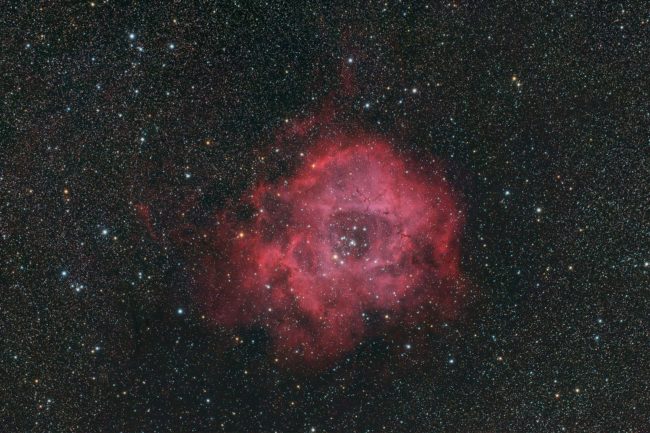
The Rosette Nebula, registred under the number Calwell 49, is an H-II region in the constellation Unicorn. As it is not a very well-known or easily identifiable constellation, so we start from Orion to locate it. It is east of Orion, in the extension of the line formed by Meissa (Lambda Orionis) and Betelgeuse. There are several entries from the NGC catalog:
- NGC 2237: the western part
- NGC 2238: another part of the nebula
- NGC 2244 (= NGC 2239): the cluster open in the center
- NGC 2246: another Rosette emission region
112 x 1 min
Camera : Nikon Z6 partially unfiltered
Telescope : Takahashi FSQ-106ED refractor.
Mount : Takahashi EM-200 homemade electronics.
Guiding : ZWO ASI290MM Mini on QHY OAG-M
Temperature : 2°C
Humidity : 68%
SQM : 21
Software : auto-guiding with PHD2, acquisition with Astro Photography Tool, processing with PixInsight.
Location : Le Plan, Col du Banchet

